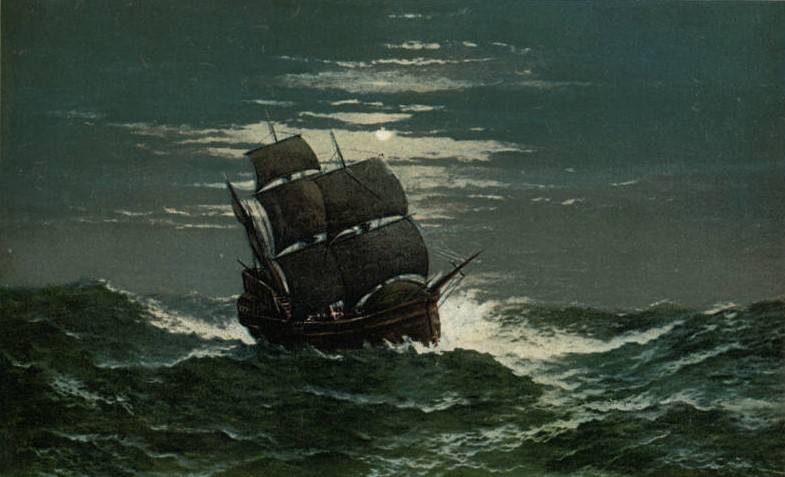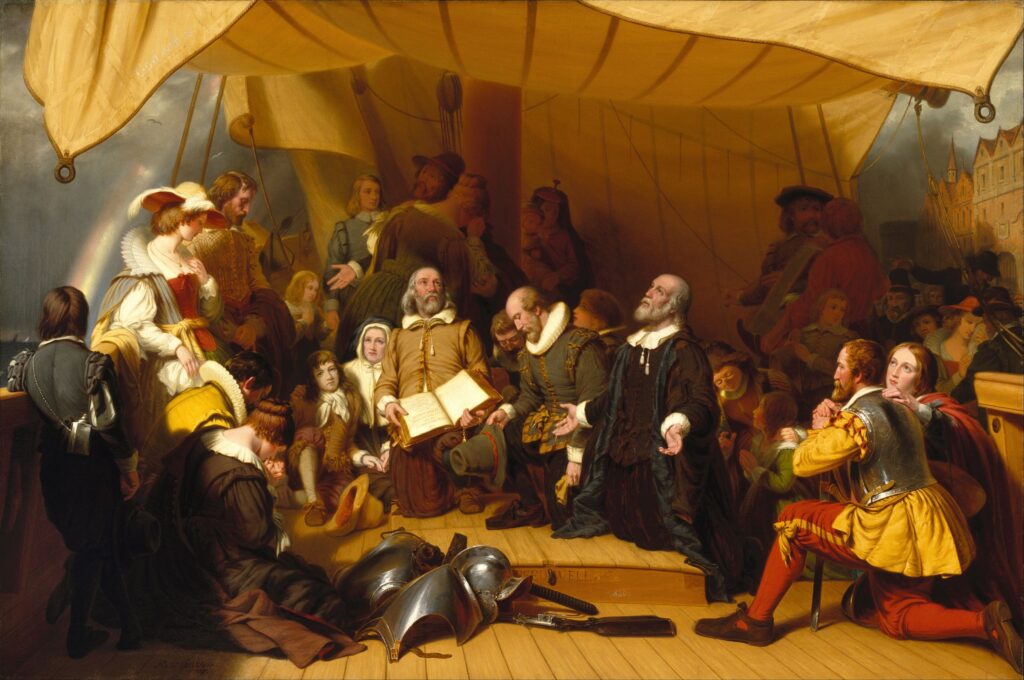How a Girl Named Remember, Age 5, and Her Fellow Pilgrims Endured the Crossing of the North Atlantic To Reach America
They weighed turning back but placed their faith in God and sailed into immortality.

As Americans gather for Thanksgiving, they celebrate the legacy of the Pilgrims’ success. Lost in the holiday’s mythology are the travails endured by passengers on the Mayflower — a tiny, rickety ship never meant for passengers or an ocean crossing — and the inspiration of their perseverance.
Paintings of the Pilgrims’ arrival at Plymouth, Massachusetts, in 1620 depict them as dignified, healthy, and well-dressed. Large, silver buckles sparkle on their hats and shoes. In reality, they had no such bling, and the Mayflower herself — all of 100 feet long — was coming apart at the seams.
The Mayflower was 100 feet long and 25 feet at her widest. “We may imagine a rather battered-looking wooden ship,” Rebecca Fraser, author of “The Mayflower,” once told me in our History Author Show interview, and it was “not in good shape.” Ms. Fraser was, in the best sense of the phrase, given to understatement.
The best ship the Pilgrims could afford, the Mayflower was built to haul lumber, fish, and wine. Its bulky design made it difficult to sail against the strong, angry crosswinds of the North Atlantic, which is why the voyage from England to America took over two months.
The Mayflower had to turn back twice because its sister ship, the optimistically named Speedwell, kept springing leaks. When the Mayflower decided to go alone in the autumn of 1620, its passengers faced not just frigid weather, but the constant threat of pirates.

There were no bathrooms on the Mayflower. Passengers traveled in the dank, suffocating, windowless “gun deck” with a ceiling about five-feet high. They slept on top of each other, rigging makeshift dividers for a minimum of privacy.
Much of the gun deck was taken up by masts, storage, and a shallop. The 102 passengers — 41 Pilgrims fleeing persecution by the Church of England and 61 non-separatists called Strangers — shared less than 14 square feet per person, ten less than a burial plot.
The second governor of the Plymouth Colony, William Bradford, wrote that everyone’s clothes were damp and dirty all the time. While the crew sometimes let passengers out for air and sunlight, the slippery deck was, given the sudden waves, risky even for seasoned sailors.
In one storm, a Pilgrim, John Howland, was swept into the ocean. He caught a halyard, and the crew retrieved him with a boathook. Among his descendants are the two Presidents Bush, as well as the Baldwin acting family, and President Franklin Roosevelt. So it could be said that the Free World of the future was saved by a boathook.
An indentured servant, William Butten, was less fortunate. Sick for much of the trip, he died just three days short of land. It was seen as a miracle that his was the only death. The loss was balanced by one of three pregnant passengers giving birth to a daughter she named Oceanus.*
Fresh food ran out fast; the passengers subsisted on preserved meats and fish — salted, pickled, dried — and biscuits. Because fresh water spoiled, too, they drank beer. It tasted more like malt liquor than the variety of brews we’ll enjoy while cheering the NFL’s Thanksgiving games.

By the end of the 3,000-mile journey, even these unappetizing supplies were running low. Due to a lack of Vitamin C, everyone developed scurvy. This resulted in joint and muscle pain, bleeding gums, loose teeth, skin lesions, anemia, and poor healing of wounds.
Children from a few months old to 15 wailed, pigs and other livestock stank. When a storm hit mid-voyage, mothers embraced children and fathers enveloped both. If the Mayflower broke apart, they’d go to their watery graves together.
The crew hauled in the sails to keep them from tearing and the masts from snapping. This left the Mayflower at the mercy of the sea, bobbing like a cork, and the ocean’s fury snapped one of the massive wooden beams supporting its frame.
The structural damage was so severe, the crew considered returning to England — an easier trip with the wind at their backs. But one of the colonists had brought a metal jackscrew to help construct new homes.
The “great iron screw” hoisted the cracked beam back into place so the Mayflower could resume its limp toward the New World. The Pilgrims, Bradford wrote, “committed themselves to the will of God.”
Bradford recorded the Pilgrims’ joy upon at last catching sight of Cape Cod. “They fell upon their knees,” he wrote, “and blessed the God of heaven, who had brought them over the vast and furious ocean.”
Before disembarking, the Pilgrims created the Mayflower Compact. A historian, George Bancroft, called it “the birth of constitutional liberty,” writing that “in the cabin of the Mayflower, humanity recovered its rights and instituted government on the basis of ‘equal laws’ for the general good.”
Sick, hungry, and scared, the Pilgrims laid out how their colony would be designed and liberty for their posterity enshrined. Given the chance to return to the Old World with the Mayflower and her crew, all chose to stay.
The passengers had to spend more months on the anchored Mayflower while shelters were constructed. “When later settlers arrived,” Ms. Fraser said, the Pilgrims’ clothes were reduced to rags. “There’s a record,” Ms. Fraser said, “saying some looked almost naked and newcomers were really aghast.” Bradford recorded that, seeing “their low and poor condition,” some of these new migrants “started weeping.”
About half the people on the Mayflower died that first winter, including Bradford’s wife, from what he called “general sickness” of colds, coughs, and fevers. With a bounty born out of farms and trade, the Pilgrims invited their Wampanoag allies to a feast of thanksgiving to God in November 1621.
Today, it’s hard to imagine the hardships endured to cross the Atlantic aboard the Mayflower. Thanksgiving is a day to celebrate the Pilgrims’ grit — a legacy ensuring that whatever the seas we sail, our life journeys are a lot smoother because of their sacrifice.
________
* Another beautifully named Pilgrim was Remember Allerton, age 5.

